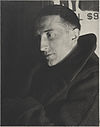
Gambling is the wagering of something of value on a random event with the intent of winning something else of value, where instances of strategy are discounted. Gambling thus requires three elements to be present: consideration, risk (chance), and a prize. The outcome of the wager is often immediate, such as a single roll of dice, a spin of a roulette wheel, or a horse crossing the finish line, but longer time frames are also common, allowing wagers on the outcome of a future sports contest or even an entire sports season.

Roulette is a casino game which was likely developed from the Italian game Biribi. In the game, a player may choose to place a bet on a single number, various groupings of numbers, the color red or black, whether the number is odd or even, or if the numbers are high (19–36) or low (1–18).

Henri-Robert-Marcel Duchamp was a French painter, sculptor, chess player, and writer whose work is associated with Cubism, Dada, and conceptual art. He is commonly regarded, along with Pablo Picasso and Henri Matisse, as one of the three artists who helped to define the revolutionary developments in the plastic arts in the opening decades of the 20th century, responsible for significant developments in painting and sculpture. He has had an immense impact on 20th- and 21st-century art, and a seminal influence on the development of conceptual art. By the time of World War I, he had rejected the work of many of his fellow artists as "retinal", intended only to please the eye. Instead, he wanted to use art to serve the mind.
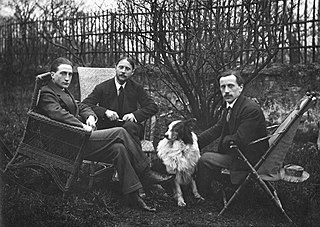
Jacques Villon, also known as Gaston Duchamp, was a French Cubist and abstract painter and printmaker.
Conceptual art, also referred to as conceptualism, is art in which the concept(s) or idea(s) involved in the work are prioritized equally to or more than traditional aesthetic, technical, and material concerns. Some works of conceptual art may be constructed by anyone simply by following a set of written instructions. This method was fundamental to American artist Sol LeWitt's definition of conceptual art, one of the first to appear in print:
In conceptual art the idea or concept is the most important aspect of the work. When an artist uses a conceptual form of art, it means that all of the planning and decisions are made beforehand and the execution is a perfunctory affair. The idea becomes a machine that makes the art.
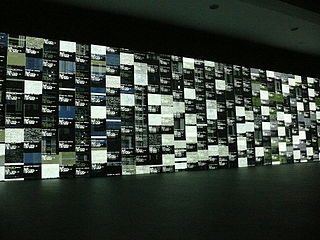
Postmodern art is a body of art movements that sought to contradict some aspects of modernism or some aspects that emerged or developed in its aftermath. In general, movements such as intermedia, installation art, conceptual art and multimedia, particularly involving video are described as postmodern.
Online casinos, also known as virtual casinos or Internet casinos, are online versions of traditional casinos. Online casinos enable gamblers to play and wager on casino games through the Internet. It is a prolific form of online gambling.
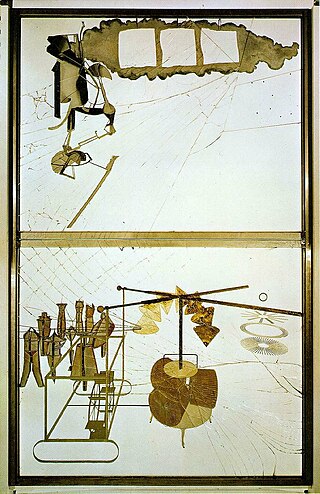
The Bride Stripped Bare by Her Bachelors, Even, most often called The Large Glass, is an artwork by Marcel Duchamp over 9 feet (2.7 m) tall and almost 6 feet (1.76m) wide. Duchamp worked on the piece from 1915 to 1923 in New York City, creating two panes of glass with materials such as lead foil, fuse wire, and dust. It combines chance procedures, plotted perspective studies, and laborious craftsmanship. Duchamp's ideas for the Glass began in 1912, and he made numerous notes and studies, as well as preliminary works for the piece. The notes reflect the creation of unique rules of physics, and myth which describes the work.

Anti-art is a loosely used term applied to an array of concepts and attitudes that reject prior definitions of art and question art in general. Somewhat paradoxically, anti-art tends to conduct this questioning and rejection from the vantage point of art. The term is associated with the Dada movement and is generally accepted as attributable to Marcel Duchamp pre-World War I around 1914, when he began to use found objects as art. It was used to describe revolutionary forms of art. The term was used later by the Conceptual artists of the 1960s to describe the work of those who claimed to have retired altogether from the practice of art, from the production of works which could be sold.

Fountain is a readymade sculpture by Marcel Duchamp in 1917, consisting of a porcelain urinal signed "R. Mutt". In April 1917, an ordinary piece of plumbing chosen by Duchamp was submitted for an exhibition of the Society of Independent Artists, the inaugural exhibition by the Society to be staged at the Grand Central Palace in New York. When explaining the purpose of his readymade sculpture, Duchamp stated they are "everyday objects raised to the dignity of a work of art by the artist's act of choice." In Duchamp's presentation, the urinal's orientation was altered from its usual positioning. Fountain was not rejected by the committee, since Society rules stated that all works would be accepted from artists who paid the fee, but the work was never placed in the show area. Following that removal, Fountain was photographed at Alfred Stieglitz's studio, and the photo published in the Dada journal The Blind Man. The original has been lost.

Nude Descending a Staircase, No. 2 is a 1912 painting by Marcel Duchamp. The work is widely regarded as a Modernist classic and has become one of the most famous of its time. Before its first presentation at the 1912 Salon des Indépendants in Paris it was rejected by the Cubists as being too Futurist. It was then exhibited with the Cubists at Galeries Dalmau's Exposició d'Art Cubista, in Barcelona, 20 April–10 May 1912. The painting was subsequently shown, and ridiculed, at the 1913 Armory Show in New York City.
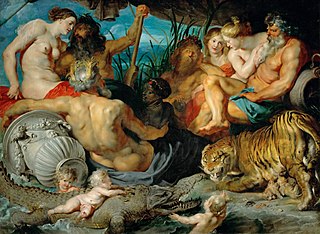
A work of art, artwork, art piece, piece of art or art object is an artistic creation of aesthetic value. Except for "work of art", which may be used of any work regarded as art in its widest sense, including works from literature and music, these terms apply principally to tangible, physical forms of visual art:
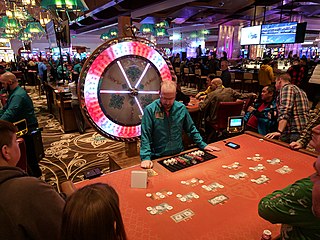
The Big Six wheel is an unequal game of chance, played using a large vertical wheel that can be spun.
Art intervention is an interaction with a previously existing artwork, audience, venue/space or situation. It is in the category of conceptual art and is commonly a form of performance art. It is associated with Letterist International, Situationist International, Viennese Actionists, the Dada movement and Neo-Dadaists. More latterly, intervention art has delivered Guerrilla art, street art plus the Stuckists have made extensive use of it to affect perceptions of artworks they oppose and as a protest against existing interventions.
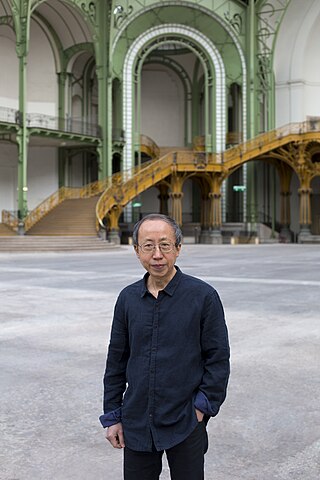
Huáng Yǒng Pīng was a Chinese-French contemporary artist and one of the most well known Chinese avant-garde artists of his time. Born in Xiamen, he was recognized as the most controversial and provocative artist of the Chinese art scene of the 1980s.

L.H.O.O.Q. is a work of art by Marcel Duchamp. First conceived in 1919, the work is one of what Duchamp referred to as readymades, or more specifically a rectified ready-made. The readymade involves taking mundane, often utilitarian objects not generally considered to be art and transforming them, by adding to them, changing them, or simply renaming and reorienting them and placing them in an appropriate setting. In L.H.O.O.Q. the found object is a cheap postcard reproduction of Leonardo da Vinci's early 16th-century painting Mona Lisa onto which Duchamp drew a moustache and beard in pencil and appended the title.
Leonardo da Vinci's Mona Lisa is one of the most recognizable and famous works of art in the world, and also one of the most replicated and reinterpreted. Mona Lisa replicas were already being painted during Leonardo's lifetime by his own students and contemporaries. Some are claimed to be the work of Leonardo himself, and remain disputed by scholars. Prominent 20th-century artists such as Marcel Duchamp and Salvador Dalí have also produced derivative works, manipulating Mona Lisa's image to suit their own aesthetic. Replicating Renaissance masterpieces continues to be a way for aspiring artists to perfect their painting techniques and prove their skills.
The Fountain Archive is a processual art project of the French conceptual artist Saâdane Afif which started in 2008/ 2009. The project includes an ongoing series of framed pages which contain one or several reproductions of the work Fountain by Marcel Duchamp. Here Afif uses the concept of the Objet trouvés and tears off the pages from different publications. For each publication and pages Afif normally makes only one piece for the Fountain Archives, which is created as a work of art.

Tulip Hysteria Co-ordinating is a fictitious work of art by Marcel Duchamp.
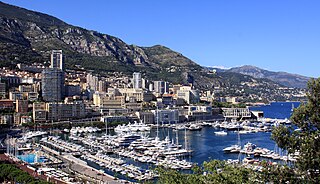
Monaco is known for its wide range of architecture for a small country. The geography of Monaco, which consists of sharp hills and narrow coastline, influences the Monacan architecture. The narrow roads have led to architectural construction being built into the hills in limited amounts of space. This limited space has, more recently, the issue of construction in Monaco has created social disruption.
















